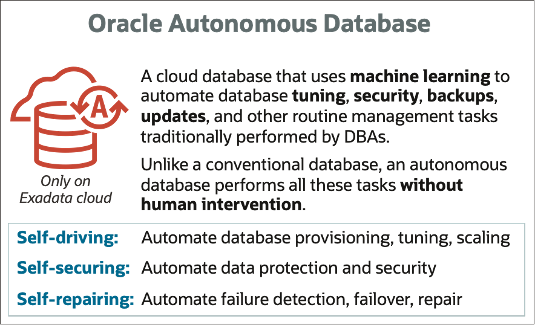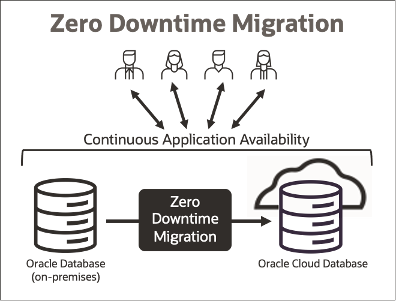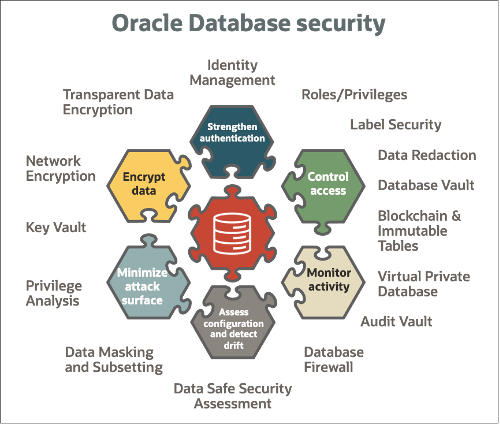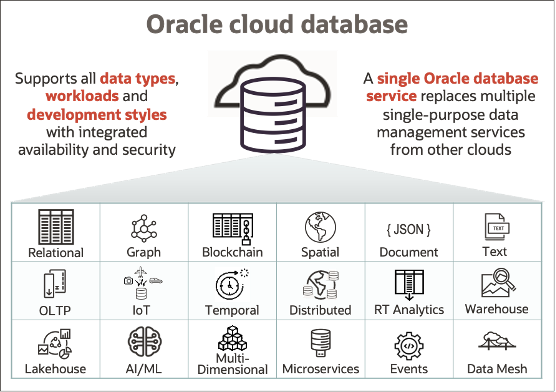In a prior blog, Key Considerations Before Migrating Oracle Databases to the Cloud, we introduced a framework to compare cloud destinations for on-premises Oracle databases. This blog takes the next step and applies that framework to Oracle, Microsoft, Google and Amazon clouds, assuming the starting point is a business-critical Oracle database on-premises. With this information, you can narrow the list of viable clouds and proceed to a more detailed comparison.
Scope and Disclaimer
The definition of “cloud” in this context includes public clouds and vendor-supplied on-premises clouds, referred to as hybrid or distributed clouds. Hybrid clouds are connected to a public cloud and managed with a common public cloud control plane.
“Business-critical” databases support applications that are fundamental to the day-to-day operations of an organization and must be secure, highly-performant, and available most or all of the time.
Comparisons here are based on publicly available information. You are encouraged to consult other sources for additional perspectives.
Comparison Criteria
As described in the previous blog, the criteria by which clouds should be compared for this purpose are as follows:
- Migration (to the cloud)
- Compatibility (with existing databases and associated applications)
- Service levels (performance, availability, manageability)
- Data protection and security
- Compliance (government or industry regulations)
- Cost
The application of these criteria to each cloud in this blog highlights the strengths and weaknesses relative to the goal of migrating and running business-critical Oracle databases.
Note: If you are running business-critical Oracle databases on-premises on Oracle Exadata, start with Exadata in the Cloud is Your Future – What Are You Waiting For?
1. Oracle Cloud and Multicloud Partnerships
Overview
Oracle’s cloud strategy includes both public cloud and hybrid cloud deployments plus a unique multicloud approach, all of which provides customers a greater number of choices to best meet their Oracle Database deployment and manageability requirements.
Oracle’s public cloud, Oracle Cloud Infrastructure (OCI), has a global footprint spanning dozens of countries, including both commercial and government cloud regions. The OCI footprint also includes a growing list of Azure, Google Cloud, and AWS regions, through the Oracle Database@Azure, Oracle Database@Google Cloud, and Oracle Database@AWS initiatives, described later. Any references to Oracle Cloud or OCI in this blog also include these initiatives.
In addition to standard cloud infrastructure, OCI supports Exadata Cloud Infrastructure, a cloud implementation of the popular Exadata Database Machine that runs Oracle databases to support the most demanding applications and workloads.
Exadata Cloud@Customer is an on-premises hybrid cloud platform, combining Exadata infrastructure and cloud services behind a customer’s firewall, while still connected to OCI for management.
Both Exadata cloud platforms (public and hybrid cloud) are used to run Exadata Database Service and/or Autonomous Database. For the purpose of moving existing Oracle databases to the Oracle Cloud, Exadata Database Service is 100% compatible with on-premises Oracle databases, as is Base Database Service, a cloud implementation of Oracle Database Standard Edition or Enterprise Edition, running on flexible compute cloud infrastructure.

Autonomous Database is a fully-automated implementation of Oracle Database that is ideal for new cloud applications. Existing Oracle databases may require minor updates to take advantage of Autonomous Database.
Multicloud Partnerships
Oracle Database@Azure is a multicloud partnership between Oracle and Microsoft for running Exadata Database Service and Autonomous Database within Microsoft Azure cloud data centers. This delivers the same benefits as running Oracle databases in OCI regions, along with extremely low multicloud latency between Azure applications and Oracle databases. Oracle Database@Azure has been generally available since December 2023.
Oracle Database@Google Cloud is a similar multicloud partnership between Oracle and Google, offering Exadata infrastructure and Oracle Database services in Google Cloud data centers, that launched in September 2024 across four regions – US East (Ashburn), US West (Salt Lake City), UK South (London), and Germany Central (Frankfurt) – and will rapidly expand to additional regions worldwide.
Oracle Database@AWS is the latest multicloud partnership to be announced in September 2024, targeted for availability in US East (N. Virginia) in December 2024, with additional regions to follow. It will also run Oracle Cloud Infrastructure (OCI) within AWS data centers, providing Exadata infrastructure support plus the fastest network connections between AWS services and Oracle databases. That means migration, compatibility, and service levels for Oracle databases will be equivalent to the Oracle Cloud.
OCI FastConnect is a high-bandwidth, dedicated connection between OCI regions and non-OCI clouds and/or on-premises data centers. FastConnect is an essential element of multicloud architectures.
Migration

Moving an Oracle database from on-premises to the cloud is easy with Oracle’s Zero Downtime Migration (ZDM), and your database and applications continue to be available during migration. ZDM uniquely performs physical migrations using methods only available to Oracle that are simple and error-free, eliminating the need to understand complex migration scenarios. Logical migration is also supported when “like to like” migration isn’t possible, such as when platforms or software versions are different.
OCI Database Migration is a free service that includes ZDM and covers a multitude of database versions and migration scenarios for a more seamless experience.
Compatibility
Every Oracle Database feature and option that is available on-premises is available in the Oracle Cloud, for 100% compatibility with existing applications. Nothing will stop working when you move your database to the Oracle Cloud.
Oracle Cloud, along with our Multicloud Partners Microsoft Azure, Google Cloud, and AWS, are the only clouds that support Real Application Clusters (Oracle RAC) and Exadata infrastructure. Oracle RAC is the foundation for Oracle Database high-availability and for scaling business-critical application performance, and Exadata is the premier platform in support of these applications.
Service Levels
For business-critical applications, maintaining or improving performance, availability and manageability are often the most important factors to consider when moving databases to the cloud. Assuming the on-premises service level agreements (SLAs) between the database owner and application users are meeting expectations, any significant deterioration could be disastrous.
The ability to duplicate on-premises Oracle Database functionality, including support for Oracle RAC and Exadata, provides a much higher probability of maintaining the same service levels, whereas moving Oracle databases to non-Exadata infrastructure in other clouds introduces the potential for significant degradation in performance and availability.
Data Protection and Security
 OCI was architected around “security-first” design principles, built for business-critical workloads. The result is a next-generation public cloud infrastructure that provides significant security benefits over first-generation clouds.
OCI was architected around “security-first” design principles, built for business-critical workloads. The result is a next-generation public cloud infrastructure that provides significant security benefits over first-generation clouds.
In addition, Oracle’s comprehensive database security strategy integrates preventive, detective, and responsive security controls throughout the entire stack – not just the database. These include authentication controls for databases, virtual machines, and infrastructure; isolation controls for networks; mandatory encryption for data at rest and in transit; and Oracle Data Safe, an integrated security service available in OCI at no additional cost.
Infrastructure and database maintenance are key components of data protection. Infrastructure for all Oracle Database cloud services is maintained by Oracle, and database and security updates are regularly released for co-managed database services, such as Exadata Database Service and Base Database Service. Security updates are automatically applied as part of the automation with Autonomous Database.
In addition to external threats, some customers may have concerns with a cloud provider’s operational access to infrastructure and services they use. Since cloud providers may have elevated privileges, maintaining security and isolation requires additional controls.
To address this concern, Oracle uniquely provides Operator Access Control (OpCtl) to limit access by Oracle Cloud Operations to sensitive systems and their underlying infrastructure. With OpCtl, customers approve operator access with reduced privileges to specific components for a period of time. OpCtl is designed for use cases where customers seek to gain the operational and financial value of a cloud implementation while meeting policy, legal, and regulatory requirements dictated to business critical applications and highly regulated industries.
Customers can also use OpCtl to monitor access with command and keystroke auditing as well as revoke access permissions. These additional protections address requirements for customers in regulated industries such as utilities and financial services, removing a previous impediment to cloud service adoption.
Oracle’s Zero Data Loss Autonomous Recovery Service is a fully managed data protection service for Oracle databases running on Oracle Cloud Infrastructure (OCI), ideal to combat modern cybersecurity and ransomware threats. Unique, automated capabilities protect Oracle Database changes in real time, validate backups without production database overhead, and enable fast, predictable recovery to any point in time. Zero data loss database protection enables you to recover protected databases to within less than a second of when an outage or ransomware attack occurred.
Compliance
Exadata cloud systems are integral to numerous security compliances and certifications attained in OCI, such as HIPAA, FedRAMP, PCI DSS, ISO, SOC and others detailed in Oracle Cloud Compliance.
Some industries may also be subject to compliance requirements that prevent public cloud adoption, mandating full physical control of data on-premises.
The Oracle Cloud@Customer hybrid cloud offerings address this with platforms for compute (Compute Cloud@Customer), databases (Exadata Cloud@Customer), and even a fully-managed on-premises cloud region (Dedicated Region Cloud@Customer).
Exadata Cloud@Customer delivers public cloud benefits while meeting stringent data residency requirements. Also, since the data is stored in customer data centers next to existing on-premises applications, customers can easily maintain their current system dependencies and response times.
Cost
There are many ways that running Oracle databases in Oracle Cloud uniquely saves costs, through database services that provide superior performance, pay-for-use billing, reduced complexity through consolidation, lower data egress charges, and on-premises license portability.
The exceptional performance, efficiency and database consolidation of Exadata infrastructure is a huge financial advantage, reducing the compute resources required per database service and the number of separate database service subscriptions. Studies by industry analysts such as Wikibon outline the economic value of Exadata performance in detail.
It’s also important to align subscription costs to actual requirements. Rather than paying for servers in the cloud configured to peak workloads, the pay-for-use elasticity of Exadata Database Service and Autonomous Database can dramatically reduce your Oracle Database licensing costs over time.
Autonomous Database’s autoscaling capabilities allow CPU and storage resources to be automatically adjusted based on actual workload requirements. When the workload increases, Autonomous Database can automatically scale up resources, and when it decreases, scale down. This ensures that performance is optimized while you only pay for the resources you actually use.
With Oracle Cloud you also have the choice of license-included or bring-your-own-license (BYOL) subscriptions for Oracle Database options. License mobility applies on-premises Oracle Database investments to reduce Oracle Cloud costs.
Most importantly, if an on-premises Oracle Database application is moved to a cloud service that cannot match or exceed the existing levels of performance and availability, no matter how much infrastructure is used, then the cost of such a mismatch in terms of user goodwill could be beyond measure.
Key Takeaways
- For business-critical Oracle databases moving to the cloud…
Oracle’s cloud strategy provides the simplest and least risky approach to ensuring minimal disruption and maximum service levels from migration through production. - Oracle Cloud Infrastructure (OCI) database services are…
The only public cloud services that support Zero Downtime Migration (ZDM), Real Application Clusters (Oracle RAC) and Exadata; essential technologies for ensuring maximum performance and availability. In addition to Oracle Cloud, OCI database services are available within Azure as of December 2023, Google Cloud as of September 2024, and are targeted to be available in AWS in December 2024. - Within Oracle’s hybrid cloud portfolio…
Exadata Cloud@Customer is the only hybrid cloud offering that supports Oracle databases. - After business-critical Oracle databases have been successfully moved into the Oracle Cloud…
New cloud-native applications are easily developed using Autonomous Database and the converged capabilities included with Oracle databases.

2. IaaS Services on Azure, Google Cloud, and AWS
Overview
As described above, Microsoft Azure, Google Cloud, and AWS all partner with Oracle to offer OCI database services within their clouds. In addition, each of these clouds also continues to offer Infrastructure as a Service (IaaS) to run Oracle databases on non-Oracle infrastructure. Everything running on the infrastructure provided, including the OS and database, is the customer’s responsibility in regards to lifecycle management, patching, and maintenance. As these services have much in common in terms of both functionality and the additional work required with IaaS, we will consider them as a group in this section.
Azure supports customer-managed Oracle databases in Azure virtual machines on IaaS, using the bring your own license (BYOL) approach.
Google Cloud Bare Metal Solution for Oracle provides bare metal IaaS residing in adjacent (“Region Extension”) data centers that are collocated in select Google Cloud regions, with high-speed network connections to a nearby Google data center where other GCP services reside. It also uses BYOL licensing, where GCP provides billing, support, and SLA compliant management of the physical servers. It offers similar connectivity benefits to the Oracle Interconnect for Google Cloud, but as with all IaaS services requires much more effort to install, configure, and maintain your Oracle databases when compared to the Oracle Database service offerings in OCI, including Oracle Database@Google Cloud.
In similar fashion, it is possible in AWS IaaS to provision EC2 instances with attached EBS storage where Oracle Database can be manually installed, configured, and managed, and is licensed using BYOL.
Migration
Moving on-premises Oracle databases to Azure virtual machines is a multi-step process that does not include the use of Azure Database Migration Service, since Oracle databases are not currently supported by the service.
Migration of an Oracle database to Google’s Bare Metal Solution for Oracle is a lift and shift, similar to moving between two on-premises locations, and leverages standard methods such as Oracle Data Guard, Oracle GoldenGate, Oracle Data Pump, or Oracle RMAN. Customers must bring (BYOL) their own Oracle licenses.
Google works with a number of partners who provide migration services, and also offers a Database Migration Service, but for Oracle Database these services are focused on replatforming from Oracle to other databases, which may require significant additional time and effort while not preserving the service levels Oracle Database provides.
Migration of Oracle databases to AWS IaaS running on EC2 requires a similar manual process, as the fee-based AWS Database Migration Service (DMS) is focused on moving on-premises Oracle databases to RDS for Oracle, as discussed below.
Compatibility
Oracle Database on Azure virtual machines does not support Oracle RAC, so on-premises applications that rely on it for scaling and availability will be incompatible, and alternative approaches for database high availability and scaling have significant tradeoffs.
The use of Oracle RAC in Oracle Database installations based on Google’s Bare Metal Solution for Oracle or in AWS installations based on EC2 is not supported by Oracle. The lack of Oracle RAC support significantly impacts the scalability and availability of business-critical applications.
Service Levels
Since Oracle Database on Azure virtual machines does not support Exadata infrastructure or Oracle RAC, the performance, scalability and availability of business-critical applications will be limited for those deployments.
For Oracle databases that do not use Exadata, the Google Bare Metal Solution for Oracle or a manual installation of Oracle on AWS EC2 could offer performance and availability similar to single server deployments that can be achieved on-premises. However, differences may exist in the infrastructure, as Google has a limited number of offerings within its Bare Metal Solution for Oracle.
There is no support for Exadata infrastructure with any of these offerings so some workloads, especially analytics and data warehousing, will likely decrease in performance, maybe significantly.
Data Protection and Security
If Oracle databases are deployed on Azure virtual machines, Google Bare Metal Solution for Oracle, or AWS EC2, not all of the Oracle Database security options are supported, and OCI security is not involved.
If the Google Bare Metal Solution for Oracle is used, Security in a Bare Metal Solution environment provides guidance on how to secure Oracle databases, including the use of any Oracle Database security options if customers already have licenses.
As the respective cloud vendor maintains only the underlying infrastructure for each of these IaaS offerings, it is the responsibility of the user to configure all security settings and options, backups, encryption, and any required copies via Oracle Data Guard, etc. Security Patching for all layers above the basic infrastructure is also the responsibility of the user.
Compliance
See Azure Compliance for additional information, including Azure certifications.
See Google Cloud Compliance for details on this topic in relation to Google Cloud.
See AWS Compliance for details on this topic in relation to AWS.
Cost
If business-critical Oracle databases are deployed on Azure virtual machines, Google Bare Metal Solution for Oracle, or AWS EC2 the lack of support for Exadata and Oracle RAC could lead to excessive infrastructure spending and costly service-level degradation compared to existing on-premises service levels, and compared to Oracle Database services that do support both Exadata and Oracle RAC in OCI, whether those services run in Oracle Cloud or in one of the Multicloud partnership service offerings within Azure, Google Cloud, or AWS.
It should also be noted that none of these IaaS solutions running Oracle Database support CPU autoscaling, meaning performance issues may occur during unexpected traffic spikes, and overprovisioning to compensate for this will likely result in increased costs from unused resources.
Key Takeaways
For business-critical Oracle databases moving to the cloud, IaaS solutions in Azure, Google Cloud, and AWS…
- Lack support for key features such as Oracle RAC.
- Don’t provide the performance and reliability advantages of Exadata Infrastructure.
- Require much more effort to install, configure, and maintain when compared to the Oracle Database service offerings in OCI, including multicloud solutions such as Oracle Database@Azure, Oracle Database@Google Cloud, and Oracle Database@AWS.
3. PaaS Services on AWS: RDS and RDS Custom for Oracle
Overview
In addition to the recently announced partnership with Oracle to offer Oracle Database@AWS and the IaaS offering previously discussed, AWS also offers a large number of “purpose-built” database services that are exclusive to AWS, plus Amazon RDS (Relational Database Service) for managed support of relational databases from Oracle, MySQL, MariaDB, PostgreSQL, Microsoft SQL Server, DB2, and Amazon Aurora.
These Platform as a Service (PaaS) offerings provide additional automation, eliminating the customer burden associated with the additional work required for managing Oracle Database on IaaS. Neither Microsoft Azure nor Google Cloud offer PaaS services to run Oracle Database aside from the Multicloud offerings available in partnership with Oracle.
Notably, RDS for Oracle’s license included model only supports the Standard Edition of Oracle Database. Business-critical databases are almost certain to require Oracle Database Enterprise Edition, which is only available using BYOL.
The AWS purpose-built database strategy aligns most closely with single-purpose applications, such as time-series, graphs and data warehousing. An application that combines multiple data types would thus require subscriptions for each database service plus logic to combine them and ensure data consistency, if needed.
This approach contrasts with the Oracle converged database paradigm, whereby multiple data types and data models are available to applications within a common framework, ensuring uniform data consistency and data protection from one database service.
Migration
AWS Database Migration Service (DMS) is a fee-based cloud service used to move on-premises Oracle databases to RDS for Oracle. AWS DMS is a logical migration tool developed for over 20 database sources and targets, rather than being optimized for any particular database. As such, the burden of understanding and applying a large number of steps correctly is placed on the user, whereas with Zero Downtime Migration (ZDM), focusing on only Oracle databases means the process is simple and error-resistant.
Compatibility
RDS for Oracle supports many of the features and options of Oracle Database, with the notable exceptions of Real Application Clusters (Oracle RAC), Automatic Storage Management (ASM), Database Vault, and Flashback Database, among others.
The lack of Oracle RAC support significantly impacts the scalability and availability of business-critical applications that are migrated to RDS.
If an on-premises deployment relies on any unsupported Oracle Database features and options, it is likely that changes will be required when moving the database and application to AWS. Such changes might include updates to the database schema, configuration, operational procedures or the application itself.
Service Levels
Due to the lack of support for Oracle RAC, RDS for Oracle on AWS is imited in scale and performance to a single server, and server failures could be impactful.
RDS also does not support Exadata or an equivalent database infrastructure, so moving an on-premises Exadata database to RDS could negatively impact the application users’ experience. Performance comparisons by industry analysts and customers warn of large performance drops suffered by applications moved from Exadata on-premises to RDS for Oracle.
For customers who require access at the VM or Operating System level in order to customize their Oracle configuration, AWS offers RDS Custom for Oracle, but that service has the same scale and performance limitations as those of the fully managed RDS for Oracle, and requires significant additional work to install, configure, and maintain your databases.
Data Protection and Security
As the longest provider of public cloud services with the largest total market share, AWS cloud security is critically important. Oracle Database security within AWS is part of Amazon RDS security, and each of the databases within Amazon RDS includes its own set of security tools and practices.
While RDS for Oracle does provide security functionality like basic encryption and role-based accounts, these capabilities are not automatic as in Oracle Cloud Infrastructure (OCI), and do not support key Oracle security technologies like Oracle Database Vault, or data corruption recovery technologies like Oracle Flashback.
Compliance
For industries subject to data sovereignty and regulatory requirements that prevent public cloud adoption, AWS currently does not support RDS for Oracle in their hybrid cloud offering, AWS Outposts. This limitation prevents many financial institutions, government entities and other regulated organizations from enjoying the benefits of cloud while keeping their Oracle databases on-premises.
See AWS compliance and Compliance validation for Amazon RDS for details on this topic.
Cost
For business-critical databases, the lack of AWS support for Oracle RAC, Exadata, and other Oracle Database functionality could lead to excessive infrastructure spending and costly service-level degradation compared to running such databases on OCI and Exadata infrastructure. The economic benefits of database consolidation, a hallmark of Exadata, is significant in comparison. Without Oracle RAC support, RDS for Oracle databases cannot span more than one server, and even the largest AWS system is significantly less powerful than a cluster of less costly systems. For a detailed analysis, see The Compelling Economic Value of Incomparable Database Performance.
RDS for Oracle also doesn’t support CPU autoscaling, meaning performance issues may occur during unexpected traffic spikes. But overprovisioning to compensate for this potential situation will likely result in increased costs from unused resources.
Key Takeaway
For business-critical Oracle databases moving to the cloud…
RDS and RDS Custom for Oracle lack support for critical Oracle RAC and Exadata infrastructure, likely forcing costly changes and negatively impacting application performance and availability.
Overall Takeaways
1. Oracle has multicloud partnerships with Microsoft, Google, and AWS that make Oracle Cloud Infrastructure (OCI) available inside Azure, Google Cloud, and AWS cloud regions.
This means key OCI technologies like Exadata infrastructure, Real Application Clusters (Oracle RAC), and Zero Downtime Migration (ZDM) are also available to Azure, Google Cloud, and AWS customers, and applications can connect to Oracle databases running on Exadata with very low latency.
2. Microsoft Azure, Google Cloud, and AWS also continue to offer services to run Oracle databases on non-Oracle infrastructure, but these offerings lack support for key technologies such as Oracle RAC and Exadata. This calls into question their suitability for business-critical databases.
Moving on-premises Oracle databases that rely on these technologies to a cloud service that doesn’t support them could significantly degrade the performance and availability of existing applications and increase costs and complexity.
3. Oracle’s hybrid cloud (Cloud@Customer) is the only hybrid cloud offering that supports Oracle databases
Other cloud providers offer variations of on-premises hybrid clouds, none of which support Oracle databases.
Exadata Cloud@Customer is Oracle’s widely-adopted hybrid cloud platform for running Oracle Database on Exadata infrastructure. Exadata Cloud@Customer provides the benefits of the public cloud with on-premises control of your Oracle databases to address data residency, security, and application dependency concerns.


